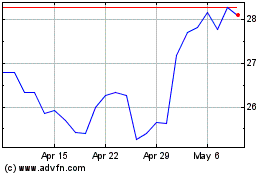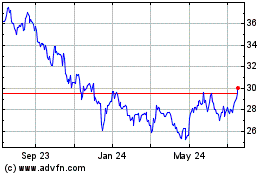- Company to Continue to Operate as
One Company with Two Distinct and Complementary Businesses to
Retain Operating Strength and Financial Flexibility
- Company Will Provide Enhanced
Financial Transparency Beginning with First-Quarter 2017
- Single-Company Structure Best
Positions Pfizer to Deliver on Its Purpose to Deliver Medicines and
Vaccines that Significantly Impact Patients’ Lives
Pfizer Inc. (NYSE:PFE) announced that, after an extensive
evaluation, the company’s Board of Directors and Executive
Leadership Team have determined the company is best positioned to
maximize future shareholder value creation in its current structure
and will not pursue splitting Pfizer Innovative Health and Pfizer
Essential Health into two, separate publicly traded companies at
this time.
“With this decision, our two distinct businesses will remain
separately managed units within Pfizer, which we believe is
currently the best structure to continue to deliver on our
commitments to patients, physicians, payers and governments, and to
drive value for our shareholders,” stated Ian Read, chairman and
chief executive officer. “We believe that by operating two separate
and autonomous units within Pfizer we are already accessing many of
the potential benefits of a split – sharper focus, increased
accountability, and a greater sense of urgency – while also
retaining the operational strength, efficiency and financial
flexibility of operating as a single company as compared with
operating as two, separate publicly traded companies. We will
continue to generate the financial information necessary to
preserve our option to split our businesses should factors
materially change at some point in the future.”
As the company previously indicated, the process for making a
decision was guided by criteria that included evaluating the
performance of each business within Pfizer, determining if each
business could compete as a stand-alone entity, assessing if
trapped value existed in a combined entity and if any trapped value
could be unlocked efficiently. In addition, the company evaluated
whether key strategic and operating imperatives could best be
achieved in the current structure versus two, separate publicly
traded companies.
Both the Innovative Health and Essential Health businesses have
delivered solid year-over-year performance over the course of the
past three years, as well as strong performance through the first
half of 2016, demonstrating their ability to compete on a
standalone basis.
“When we first explored the trapped value question several years
ago, market valuations of other companies suggested that our two
businesses could potentially be worth more as separate companies
than they are together in a single company,” explained Frank
D’Amelio, executive vice president, Business Operations and Chief
Financial Officer. “However, over time, any potential gap between
Pfizer’s market valuation and an implied Sum of the Parts (SOTP)
market valuation has closed. In our analysis, we concluded that
splitting into two companies at this time would not enhance the
cashflow generation and competitive positioning of the businesses
and the operational disruption, increased costs of a split and
inability to realize any incremental tax efficiencies would likely
be value destructive.”
Pfizer believes it is poised to grow its Innovative Health and
Essential Health businesses, so that they can be leaders in their
markets. Over the past several years, the company rebuilt its
pipeline and transformed its approach to R&D. Pfizer also
created a dedicated R&D capability for its Essential Health
business and formed the Global Product Development Group, which is
a unified center for late-stage development to maximize the value
of its R&D investments. Since 2010, Pfizer received 20 new drug
approvals and launched multiple products to address patients unmet
medical needs, including Ibrance, Xalkori, Bosulif, Inlyta,
Eliquis, Prevnar Adult and Trumenba. In addition, the company has
established an industry leading portfolio of sterile injectables,
biosimilars and effective, high-value treatments that have lost
their market exclusivity.
Pfizer Innovative Health is growing with incremental revenues
from the company’s most recently launched products and is further
strengthened by the acquisition of Anacor and the pending
acquisition of Medivation. Pfizer believes that its Essential
Health business is positioned to return to sustainable growth over
the next few years driven by the sterile injectables and
biosimilars businesses, and anticipated continued growth in
emerging markets. The business was further bolstered with the
acquisition of Hospira and Innopharma, and the pending acquisition
of AstraZeneca’s small molecule anti-infectives business.
Over the same period, Pfizer captured approximately $32 billion
from the disposition of its Capsugel and Nutrition businesses, and
the IPO and share exchange associated with the spinoff of its
Animal Health business, and has returned $88.1 billion to
shareholders through dividends and share repurchases since 2010.
The company remains committed to creating value for its
shareholders, and will continually evaluate the composition of its
portfolio to determine the optimal mix of businesses for maximizing
that value.
To further outline the financial performance of its two
businesses, the Company will begin to more fully allocate indirect
expenses for each of its two businesses by including estimates of
the dollar value of such expenses, where appropriate. This will
commence with the publicly-disclosed quarterly financials for the
first-quarter 2017.
Pfizer will move forward with a focus on its strategic
priorities to grow and increase operational efficiency to be more
competitive. This decision announced today does not impact 2016
financial guidance, and the company reaffirmed its guidance for
2016, which was issued on August 2, 2016.
DISCLOSURE NOTICE: The information contained in this
release is as of September 26, 2016. Pfizer assumes no obligation
to update forward-looking statements contained in this release as
the result of new information or future events or developments.
This release contains forward-looking information related to,
among other things, Pfizer’s strategy, plans, objectives,
expectations and intentions, potential growth of its Innovative
Health and Essential Health businesses and Pfizer’s anticipated
financial results for 2016, that involves substantial risks and
uncertainties that could cause actual results to differ materially
from those expressed or implied by such statements. Risks and
uncertainties include, among other things, risks related to the
ability to close the pending acquisitions of Medivation and
AstraZeneca’s small molecule anti-infectivesbusiness; risks related
to the ability to realize the anticipated benefits of acquisitions,
including the possibility that the expected benefits from the
acquisitions will not be realized or will not be realized within
the expected time period; the uncertainties inherent in business
and financial planning, including without limitation, risks related
to Pfizer’s business and prospects, adverse developments in
Pfizer’s markets, or adverse developments in the U.S. or global
capital markets, credit markets or economies generally; other
business effects, including the effects of industry, market,
economic, political or regulatory conditions; future exchange and
interest rates; changes in tax and other laws, regulations, rates
and policies; future business combinations or disposals; the
uncertainties inherent in research and development, including the
ability to meet anticipated trial commencement and completion dates
and regulatory submission dates, as well as the possibility of
unfavorable clinical trial results, including unfavorable new
clinical data and additional analyses of existing clinical data;
and competitive developments.
A further description of risks and uncertainties can be found in
Pfizer’s Annual Report on Form 10-K for the fiscal year ended
December 31, 2015 and in its subsequent reports on Form 10-Q,
including in the sections thereof captioned “Risk Factors” and
“Forward-Looking Information and Factors That May Affect Future
Results”, as well as in its subsequent reports on Form 8-K, all of
which are filed with the U.S. Securities and Exchange Commission
and available at www.sec.gov and
www.pfizer.com.
View source
version on businesswire.com: http://www.businesswire.com/news/home/20160926005519/en/
PfizerMedia:Joan Campion, 212-733-2798orInvestors:Ryan Crowe,
212-733-8160
Pfizer (NYSE:PFE)
Historical Stock Chart
From Mar 2024 to Apr 2024

Pfizer (NYSE:PFE)
Historical Stock Chart
From Apr 2023 to Apr 2024
